'Star Wars' VFX Oscar nominees on making 'The Force Awakens'
"It's sort of like a combo-platter of old school and new school."

If there's one thing you can be certain to find in a Star Wars movie, it's glorious special effects. So after The Force Awakens opened last year, an Academy Award nomination for the film's VFX leads seemed inevitable. Roger Guyett and Patrick Tubach will be going up against visual effects teams behind other big-budget sci-fi films, including Mad Max: Fury Road and The Martian, as well as a rare indie nominee, Ex Machina. We sat down with Guyett and Tubach ahead of the Oscars on February 28th to explore how they went about bringing Star Wars back to life. (Warning: This interview is naturally full of spoilers.)
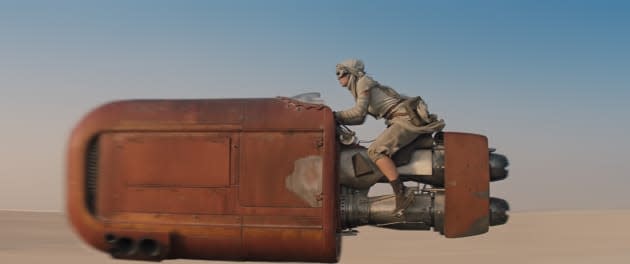
How did you approach balancing classic Star Wars effects with the need for something new?
Roger: That's exactly what was running through our minds. How do we balance those two things together? The feeling very strongly from J.J. [Abrams, the director] was to go back to the spirit of the first movies: see what were the fundamental qualities about it. A lot of it had to do with traveling to locations, building as many sets as we could. And that infused the movie with that sort of tactile quality, feeling like you're really going to those places.
[It was] a lot of collaboration between the creature department and J.J. We came up with notions of using practical creatures where we could. At the same time, it was sort of a strange thing jumping to the other end of the technology meter and going full-out on using all of the most recent contemporary technologies to create what we hoped were very photorealistic effects. Essentially we're marrying all of this together. What we're hoping for is a much more visceral, tactile thing. It's sort of like a combo platter of old school and new school.
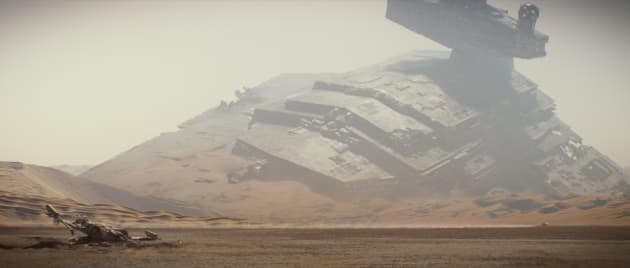
Patrick: Specifically working on the Star Destroyer, we had these moments where we're designing new ships and we're really quite proud of them. There's a lot of design work, with J.J., that went into the new Star Destroyer. It looked really cool and sleek, but there was a moment we realized we hadn't put as much of an emphasis on the top of the ship, and I think it really lost some of that Star Wars charm.
And I remember that moment, Roger, where you actually said, it really was missing something. We went back into that ship and added something in, and I think it really was that marriage of looking at something new that looks cool but wanting to bring back a bit of that old Star Wars vibe.
Can you talk a bit more about the need to balance practical and digital effects? Is that more difficult than trying to cram a lot of special effects in?
Roger: It's always one of those things where you're watching the movie, you just want to create the best and most striking things you can to support that story. Basically, how you arrive there is interesting to discuss afterwards. But what we're trying to do is make the whole thing a continuous experience. I wouldn't say necessarily we had more digital shots than The Phantom Menace. Fundamentally, the makeup of that movie was quite different.
We'd often talk a lot about whether we should do something practically or not. And sometimes, digital work is very difficult. You could go through the movie and try to figure out the digital version of BB-8. Sometimes the guys did such a great job of it; it's very difficult to tell. Fundamentally it doesn't really matter how you get there. But the thing is, it's how that image actually looks. And the technology where we are now, I think it's just possible to do things to a level where you just don't know the difference.
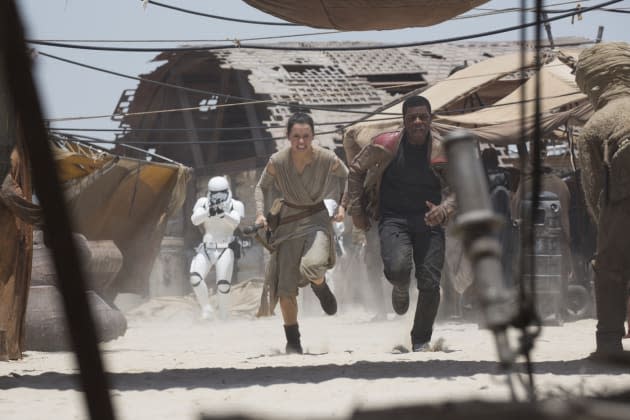
The first scene where I noticed special effects being used in a really interesting way was the Millennium Falcon escape from Jakku. It felt like I was watching something very different for a Star Wars movie. Could you talk more about how you designed that?
Patrick: Roger deserves a lot of credit for working with Paul Kavanagh, our animation supervisor on a lot of those camera moves. That chase being something that's sort of born a little bit more in post[-production]. You know going in that yes, you're going to a real location, and you're going to film that desert, but in the end, you're going to be creating camera moves and everything that require you to do more than a helicopter can do. I think the Falcon is flying at like 600 miles per hour most of the time. So going into that sequence, we had the idea from J.J. that this had to be an exciting chase, but you also want to ground it in that reality of the language of a chase sequence from a regular film that people are used to seeing, like a car chase or an air chase.
Roger: Fundamentally what that meant was that we were, along with Susumu Yukuhiro, who was in charge of our environments, we got to a place where we could rebuild that desert. Basically, from the first moment the the Millennium Falcon takes off to the end of that chase, it's a digital sequence. And our feeling was that, clearly, in order to get there we have to do a lot of leg work in terms of recording the environment and scanning it. We needed to have the flexibility to be able to move the camera. There was no way we would ever be able to recreate those camera moves in the desert, with equipment we didn't have access to.
In terms of designing that scene, how much of that came from you and how much from J.J.?
Roger: It was a big collaboration. That scene was one of the first ideas. It's such a metaphor, isn't it, of the old Star Wars you're leaving that behind. It was a sequence J.J. had discussed, and it was in one of the earliest versions of the script that I ever saw.
We started shooting in May of 2014, and J.J. was very much writing that script with Larry Kasdan [The Force Awakens co-writer, who also wrote The Empire Strikes Back and Return of the Jedi] during that pre-production period. So we didn't have the opportunity to do too much previz [previsualizations of special effects] on some of those sequences. But we did have some key moments that we knew we were going to be incorporating into that sequence.
It was very important for a number of reasons, but it really was sort of a collaboration. So there were ideas we started to incorporate into it. Like the notion that they fly off the edge of the Star Destroyer and drop down in height. J.J. would sometimes very specifically give us directions, some other times he would suggest an idea, and we'd take that and elaborate or come up with a version of it.
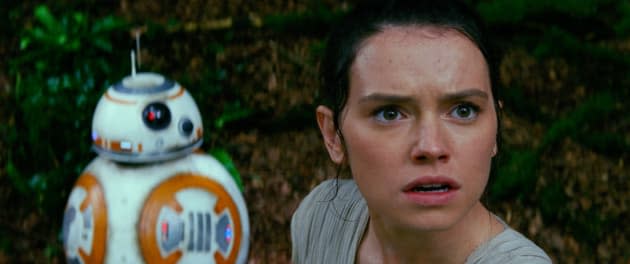
Did you always want to do BB-8 in a mostly practical way?
Roger: There were some things so fundamentally in the DNA of these movies, and one of those is obviously a droid. J.J. wanted to introduce new characters, and the notion of a new droid came up in one meeting. And actually, very early on, as he was talking about it, he actually pretty much drew BB-8 on a Post-It. And that essentially was what BB-8 turned into.
We did some tests on the size of the droid, the coloring. It's a very complicated piece of mechanics to make it work. But fundamentally the notion of having a droid that could interact with the actors, that could be puppeted, essentially we were able to direct that character. You could see it come to life, you could see the idiosyncrasies of the personality of BB-8, you could see all that happening in front of you. It was an incredible blueprint of who BB-8 was. By building it, we could also scan it, we could measure the crap out of it. We could do everything we needed to do to build an incredibly accurate digital version of it.
And the other thing, when we started to animate it, we absolutely knew what the personality was because it had been defined by the puppeteer. Essentially, it's probably digital in about a quarter or a third of the shots in the movie. It was clearly doing more complicated stunts digitally, where he was using his thumbs-up flame, or he fires the lines out to steady himself in the Millennium Falcon, when he pulls himself out of the hiding place. Things like this, and sometimes when he's going through the desert in wider shots. But the [digital] guys got incredibly good at matching the spirit of the puppeteers' performance.

The big thing all of our editors were wondering about: How did you go about changing the lightsaber effects?
Patrick: We definitely wanted to approach the lightsabers differently in this film. Having been on some of the other prequels -- I started on Episode II -- the technique for creating those was still very much stuck in the past, where basically we were just rotoscoping the sticks and applying a 2D effect. We knew that we wanted to both up the game on the production side and on the effects side.
On the production side, Roger and the practical effects team worked to create these amazing LED sabers that actually reacted to when they hit each other; you could change the color, the intensity and the temperature of the light. Of course, that gives you an awesome light source that really can service as your primary light. Then Daniel Mindel, our director of photography, could actually light some scenes very dramatically.
On the effects side, we were able to turn them into full 3D light sabers for the first time. That allowed us to have them actually clash with each other and see a reaction, and have effects that come as a result of that. That gives a sort of visceral, very brutal quality to that final lightsaber fight, where they're hitting each other and there's almost always something happening. It doesn't just seem like a couple of glowing tubes touching.
Onto Kylo Ren, specifically, that lightsaber was an idea that J.J. had that was borne out of the original intent of the character, which was Kylo Ren being the younger, angrier bad guy.
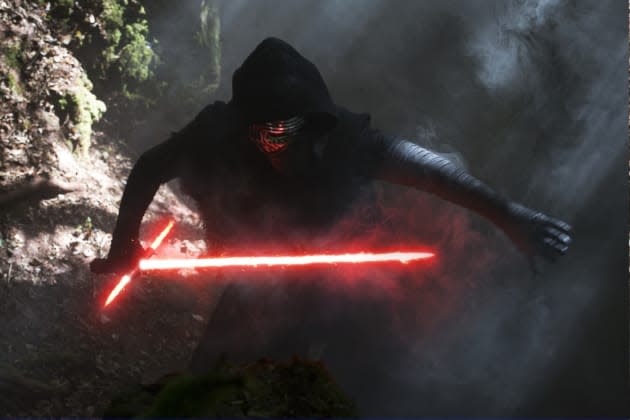
Roger: It sort of reflects his personality. It's a little tempestuous, a bit out of control. It's also home-built, as well. I think that shows him as an undeveloped bad guy.
Some of the choices in having that kind of three-part sword came out of a dinner J.J. had with Apple. Jony Ive is a very big Star Wars fan, so he had plenty to say about lightsabers. There was an opportunity to do something different. The idea was [Kylo] lightsaber being wild and out of control.

Maz Kanata [Lupita Nyong'o's character] feels almost as soulful as Yoda from Empire. Was that what you were going for with her?
Roger: For us, every choice that we were making was based on what we felt helped the movie. Trying to make sure that everything we did was specific and story driven; we weren't just going for spectacle. For Maz, we rebuilt a lot of the motion capture stuff that Industrial Light & Magic is constantly updating. Really what she represented to us was the most up-to-date version of that system. If you think about how quiet her performance was, it was really a subtle performance.
Clearly, Maz's facial physiognomy, her shape is obviously different from a human being, so we had to work very hard in translating Lupita's action to her performance. It really resonated into Maz. Lupita did a very nuanced performance, and that's what we wanted to capture. We wanted to make sure she was in the moment, so we'd always photograph her with the other actors so that they could see the way she was reacting to moments, and she could react to them. Part of that involved using more of an image-based motion capture for all the motion of her limbs.
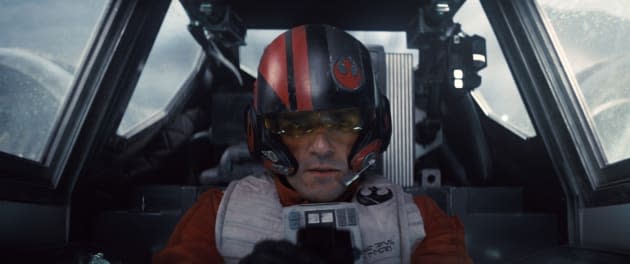
How did you approach the 3D conversion? There was one scene, when a Star Destroyer was just floating in the middle of space, where it felt like it was in my lap.
Roger: The bottom line was we wanted to make the 3D version an experience for the audience. If you just want it to be very mild, then you've got to question why you're doing these things. In other words, if people are going to pay more money to see this movie, what can we do to enhance that version, rather than making it so sedate? Sometimes, I've been guilty of this; I tend to like my 3D relatively mild. You want to give the audience an experience.
Just doing that kind of thing, the fun of seeing that Star Destroyer come out in the audience, I think for the fans, if you're interested in that world, you're just more inside it. I couldn't get over the fact that all the cockpit shots suddenly became much more interesting when you're in 3D because you really began to understand the space. It changed the way that you were able to look at that movie. We wanted to make sure it had a personality. J.J., as a fan of that world, realized with tests that by going a little stronger with 3D, the fans would just enjoy that. It's always a delicate balance.
Patrick: There is something to keeping the VFX crew and director involved in that process, even if you're doing a [3D] conversion. Obviously the technical process is one thing but then, having us sit there and consult on that stuff, and talk to them about sets not being that big ... being able to mention that really makes the difference too. And then, having J.J. weigh in and say, I think this is an opportunity to have a moment, that isn't going to break narrative continuity. Like that Star Destroyer scene, it doesn't really take you out of the movie to have a bold shot in that moment.
Roger: We worked with those guys. We built the ships, we've been on all the locations, we built the set. I was there on all the sessions with the 3D guys. We had a great team at StereoD that was very amenable, and we've worked with them many times. They've worked on the last Star Trek movie. It's about setting those moments, using the dimension appropriately.
Images courtesy of Lucasfilm. This interview has been edited and condensed.
